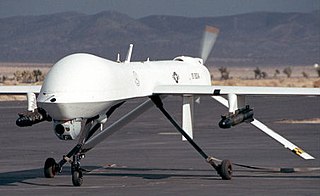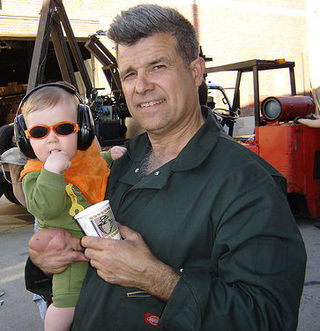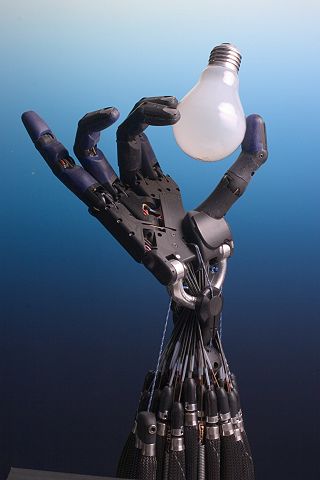
An industrial robot is a robot system used for manufacturing. Industrial robots are automated, programmable and capable of movement on three or more axes.

Robot fetishism is a fetishistic attraction to humanoid robots; also to people acting like robots or people dressed in robot costumes. A less common fantasy involves transformation into a robot. In these ways it is similar to agalmatophilia, which involves attraction to or transformation into statues or mannequins.

Military robots are autonomous robots or remote-controlled mobile robots designed for military applications, from transport to search & rescue and attack.

ASIMO is a humanoid robot created by Honda in 2000. It is displayed in the Miraikan museum in Tokyo, Japan. On 8 July 2018, Honda posted the last update of Asimo through their official page stating that it would be ceasing all development and production of Asimo robots in order to focus on more practical applications using the technology developed through Asimo's lifespan. The name was chosen in honor of Isaac Asimov. It made its last active appearance in March 2022, over 20 years after its first, as Honda announced that they are retiring the robot to concentrate on remote-controlled, avatar-style, robotic technology.

FANUC is a Japanese group of companies that provide automation products and services such as robotics and computer numerical control wireless systems. These companies are principally FANUC Corporation of Japan, Fanuc America Corporation of Rochester Hills, Michigan, USA, and FANUC Europe Corporation S.A. of Luxembourg.

BigDog is a dynamically stable quadruped military robot that was created in 2005 by Boston Dynamics with Foster-Miller, the NASA Jet Propulsion Laboratory, and the Harvard University Concord Field Station. It was funded by DARPA, but the project was shelved after the BigDog was deemed too loud for combat.

Mark Pauline is an American performance artist and inventor, best known as founder and director of Survival Research Laboratories. He is a 1977 graduate of Eckerd College in St. Petersburg, Florida.

Legged robots are a type of mobile robot which use articulated limbs, such as leg mechanisms, to provide locomotion. They are more versatile than wheeled robots and can traverse many different terrains, though these advantages require increased complexity and power consumption. Legged robots often imitate legged animals, such as humans or insects, in an example of biomimicry.

The ethics of artificial intelligence is the branch of the ethics of technology specific to artificially intelligent systems. It is sometimes divided into a concern with the moral behavior of humans as they design, make, use and treat artificially intelligent systems, and a concern with the behavior of machines, in machine ethics.

Sarcos Technology and Robotics Corporation is an American developer of robotics and microelectromechanical systems and related technologies. It was founded in the early 1980s when it was spun out from the University of Utah. The company specializes in creating robotic systems for military and industrial applications. Sarcos' work can be found in a wide variety of applications, ranging from the robotic pirates and dinosaurs at theme parks to the robotic fountains in front of the Bellagio in Hotel in Las Vegas, to NASA space suit testing equipment, prosthetic limbs, and MEMS sensors. Time Magazine named Sarcos’ Guardian XO full-body, powered exoskeleton one of “The 100 Best Inventions of 2020”.
Spirax-Sarco Engineering plc is a British manufacturer of steam management systems and peristaltic pumps and associated fluid path technologies. It is headquartered in Cheltenham, England. It is listed on the London Stock Exchange and is a constituent of the FTSE 100 Index.
In artificial intelligence, apprenticeship learning is the process of learning by observing an expert. It can be viewed as a form of supervised learning, where the training dataset consists of task executions by a demonstration teacher.

Robots of the United States include simple household robots such as Roomba to sophisticated autonomous aircraft such as the MQ-9 Reaper that cost 18 million dollars per unit. The first industrial robot, robot company, and exoskeletons as well as the first dynamically balancing, organic, and nanoscale robots originate from the United States.
A euthanasia device is a machine engineered to allow an individual to die quickly with minimal pain. The most common devices are those designed to help terminally ill people die by voluntary euthanasia or assisted suicide without prolonged pain. They may be operated by a second party, such as a physician, or by the person wishing to die. There is an ongoing debate on the ethics of euthanasia and the use of euthanasia devices.

Robotics is an interdisciplinary branch of electronics and communication, computer science and engineering. Robotics involves the design, construction, operation, and use of robots. The goal of robotics is to design machines that can help and assist humans. Robotics integrates fields of mechanical engineering, electrical engineering, information engineering, mechatronics engineering, electronics, biomedical engineering, computer engineering, control systems engineering, software engineering, mathematics, etc.

The Wayback Machine is a digital archive of the World Wide Web founded by the Internet Archive, a nonprofit based in San Francisco, California. Created in 1996 and launched to the public in 2001, it allows the user to go "back in time" to see how websites looked in the past. Its founders, Brewster Kahle and Bruce Gilliat, developed the Wayback Machine to provide "universal access to all knowledge" by preserving archived copies of defunct web pages.

Gilberto Emiro Correa Romero is a Venezuelan television personality known for hosting De Fiesta Con Venevision from 1969–1983 and Súper Sábado Sensacional from 1988 to 1996. Correa is also best known for his deep voice on Venevision's commercial bumpers and promos during the 1980s and 1990s.

A powered exoskeleton is a mobile machine that is wearable over all or part of the human body, providing ergonomic structural support and powered by a system of electric motors, pneumatics, levers, hydraulics or a combination of cybernetic technologies, while allowing for sufficient limb movement with increased strength and endurance. The exoskeleton is designed to provide better mechanical load tolerance, and its control system aims to sense and synchronize with the user's intended motion and relay the signal to motors which manage the gears. The exoskeleton also protects the user's shoulder, waist, back and thigh against overload, and stabilizes movements when lifting and holding heavy items.

Tekno the Robotic Puppy is a popular electronic robotic toy which originally launched in late 2000. Tekno sold more than 7 million units in its first season and went on to sell more than 40 million units in its original 4 years of production. The worldwide popularity for Tekno led to prominent awards and widespread media coverage which included newspaper articles, television and film appearances, and a stand-alone feature on the cover of Time magazine.

The Sarco pod is a euthanasia device or machine consisting of a 3D-printed detachable capsule mounted on a stand that contains a canister of liquid nitrogen to die by suicide through inert gas asphyxiation. "Sarco" is short for "sarcophagus". It is used in conjunction with an inert gas (nitrogen) which decreases oxygen levels rapidly which prevents panic, sense of suffocation and struggling before unconsciousness, known as the hypercapnic alarm response caused by the presence of high carbon dioxide concentrations in the blood. The Sarco was invented by euthanasia campaigner Philip Nitschke in 2017. Nitschke said in 2021 that he sought and received legal advice about the device's legality in Switzerland.
















